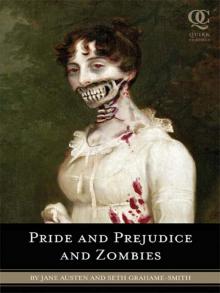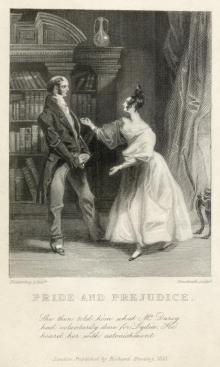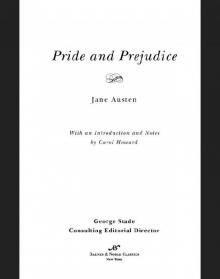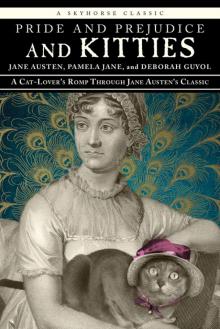- Home
- Jane Austen
The Annotated Persuasion
The Annotated Persuasion Read online
AN ANCHOR BOOKS ORIGINAL, OCTOBER 2010
Copyright © 2010 by David M. Shapard
All rights reserved. Published in the United States by Anchor Books, a division of Random House, Inc., New York, and in Canada by Random House of Canada Limited, Toronto.
Anchor Books and colophon are registered trademarks of Random House, Inc.
Library of Congress Cataloging-in-Publication Data
Austen, Jane, 1775–1817.
[Persuasion]
The annotated Persuasion / by Jane Austen; annotated and edited, with an introduction by David M. Shapard.
p. cm.
Includes bibliographical references.
eISBN: 978-0-307-95023-9
1. Austen, Jane, 1775–1817. Persuasion. 2. Young women—England—Fiction. 3. Gentry—England—Fiction. 4. Mate selection—Fiction. 5. Ship captains—Fiction. 6. England—Social life and customs—19th century—Fiction. I. Shapard, David M. II. Title.
PR4034.P4 2010
823’.7—dc22
2010021617
Book design by Rebecca Aidlin
Maps by R. Bull
www.anchorbooks.com
v3.1
Cover painting: Watercolor of Jane Austen by her sister Cassandra Austen, 1804 © The Granger Collection, New York.
Cover design by Megan Wilson.
Woman in contemporary dress at the seaside, with bathing machines in the background.
[From William Alexander, Picturesque Representations of the Dress & Manners of the English (1813)]
Annotations to the Front Cover
1. This is a watercolor sketch of Jane Austen by her sister, Cassandra. Sketching and drawing were among the most popular of the various accomplishments ladies of the time were taught and encouraged to pursue; others are discussed in this novel.
2. The picture was made while the Austen family was visiting Lyme Regis, on the southern coast of England. An excursion to Lyme, a popular vacation spot, plays a central role in Persuasion.
3. Jane Austen’s face is unfortunately obscured by her bonnet. It was standard then for people to wear hats or bonnets when outdoors; women also usually wore caps indoors.
4. Cassandra made this picture during one of her outings with Jane to the picturesque countryside near Lyme, which is described as “very fine” in Persuasion. Jane Austen’s love of natural beauty appears in her letters, and she gives that same love to the heroine of this novel, Anne Elliot.
Contents
Cover
Title Page
Copyright
Annotations to the Front Cover
Notes to the Reader
Acknowledgments
Introduction
PERSUASION
VOLUME I
(Note: The following chapter headings are not found in the novel. They are added here by the editor to assist the reader.)
I Sir Walter Elliot
II The Decision to Move to Bath
III The Crofts to Be Tenants
IV Anne and Captain Wentworth
V Anne’s Arrival at the Musgroves’
VI The Arrival of the Crofts
VII The Arrival of Captain Wentworth
VIII Captain Wentworth’s Naval History
IX Captain Wentworth and the Miss Musgroves
X The Long Walk in the Country
XI The Visit to Lyme
XII The Accident at Lyme
VOLUME II
I Anne’s Move to Lady Russell’s
II Anne’s Arrival in Bath
III The First Evening in Bath
IV Anne and Mr. Elliot
V Anne and Mrs. Smith
VI The News of Louisa’s Engagement
VII Captain Wentworth’s Arrival in Bath
VIII The Meeting at the Concert
IX Mrs. Smith and Mr. Elliot
X The Musgroves’ Arrival in Bath
XI Captain Wentworth’s Letter
XII Conclusion
Notes
Chronology
Bibliography
Maps
About the Author
Other Books by This Author
Notes to the Reader
The Annotated Persuasion contains several features
that the reader should be aware of:
Literary interpretations: the comments on the techniques and themes of the novel, more than other types of entries, represent the personal views and interpretations of the editor. Such views have been carefully considered, but inevitably they will still provoke disagreement among some readers. I can only hope that even in those cases the opinions expressed provide useful food for thought.
Differences of meaning: many words then, like many words now, had multiple meanings. The meaning of a word that is given at any particular place is intended to apply only to the way the word is used there; it does not represent a complete definition of the word in the language of the time. Thus some words are defined differently at different points, while many words are defined only in certain places, since in other places they are used in ways that remain familiar today.
Repetitions: this book has been designed so it can be used as a reference. For this reason many entries refer the reader to other pages where more complete information about a topic exists. This, however, is not practical for definitions of words, so definitions of the same word are repeated at each appropriate point, except in cases when such definitions are extremely close together.
Acknowledgments
My first, and greatest, expression of gratitude must go to my editor, Diana Secker Tesdell. She has patiently responded to a continued series of questions and concerns throughout the gestation of this book, and she has played a vital role in the preparation of the manuscript, sharpening up the prose, forcing me to clarify my ideas, and identifying several important points in the novel that I had missed. Further thanks are owed to Nicole Pedersen and to others at Anchor Books for their work in preparing the final manuscript.
I am also grateful to Professor Phyllis Roth of Skidmore College, and her seminar class on Jane Austen, who allowed me to participate in two lively discussions that were enjoyable and useful in stimulating my thinking about Austen and Persuasion.
Additional thanks go to the staff of the Bethlehem Public Library, the New York State Library, and the New York Public Library for helping me procure the materials essential for my research, with particular appreciation for the efforts of Gordon Noble at the first institution and Elizabeth C. Denlinger at the last one.
Finally, I must thank my mother and other members of my family for their continued encouragement and support.
Introduction
Persuasion was the last complete novel by Jane Austen, the capstone to a literary career that started when she was young. Born on December 16, 1775, in the southern English county of Hampshire, she grew up in a large family of six boys and two girls that valued books and education. Her father, George Austen, was a clergyman and her mother, Cassandra Austen Leigh, whose father was a clergyman, came from a family mostly of landed gentry; thus Jane Austen grew up among the social class she consistently depicts in her novels. Her father supplemented his income by running a school for boys, and several of her brothers tried their hand at literary composition. The family also encouraged Jane’s literary efforts, the first surviving examples of which date to when she was thirteen. Her earliest writings were highly comical and show the influence of other literary works of the time, many of which she satirized. As she matured, she wrote longer and more serious works, which reveal an increasing interest in the delineation of character. In 1795 she wrote her first full novel, Elinor and Marianne, and followed this in the next few years with First Impressions and Susan. She tried t
o publish the latter two books, but without success.
During this time Jane Austen lived with her parents and her sister, Cassandra, in Steventon. Her surviving letters indicate regular attendance at balls and other social events, and an interest in men, but no sustained romance or offer of marriage. The first known major event of her life occurred in 1801, when her father retired and moved the family to the popular spa and resort town of Bath, which was to serve as the setting for a substantial portion of Northanger Abbey and Persuasion. The family lived there, at various addresses, for the next four years. In 1805 Mr. Austen died, after which Mrs. Austen and her two daughters left Bath, settling eventually in Southampton, a port city in Hampshire. During this whole period Jane Austen did not complete any other novels; she also rejected, after briefly accepting, her one known offer of marriage. Finally, in 1809, she and her mother and sister were able to move into a cottage owned by her brother Edward in the quiet village of Chawton in Hampshire.
In these new circumstances Jane Austen resumed her writing with vigor. In 1810 she finished Sense and Sensibility, a revised version of Elinor and Marianne. In 1811 it became her first published book—though not one that revealed her name, for its title page simply read, “By a Lady.” Its modest success encouraged a similar revision of First Impressions, resulting in the appearance of Pride and Prejudice in early 1813, and even greater success. Her next two books, Mansfield Park and Emma, appeared in 1814 and 1815, and in the latter year she began work on Persuasion. Unfortunately, she grew increasingly ill during the following year. Her ailment is not certain, though many have suggested it was what is now known as Addison’s disease, an endocrine disorder caused by a malfunction of the adrenal glands. She managed to finish Persuasion in 1816, though it is possible she was unable to revise and polish it as fully as she wished—the principal evidence for this is its short length, especially compared to the long novels that immediately preceded it, and its sketchily developed subplot involving Mr. Elliot and Mrs. Clay. She also managed to begin another novel, Sanditon. Eventually, however, she grew too weak to write, and on July 18, 1817, she died in the town of Winchester.
Shortly afterward, in December 1817, her brother Henry arranged for the joint publication of Persuasion and Northanger Abbey (the new title of Susan). He added a brief biographical notice in which he informed the world of his sister’s death and revealed her identity for the first time.
· · ·
Persuasion stands out in several ways from other Jane Austen novels. It is by far the shortest, the only one to comprise two volumes rather than three, with the exception of Northanger Abbey, which was completed many years before the final versions of any of the others and bears the mark of a much less mature author. Persuasion’s brevity is linked to other features that distinguish it from the other novels. While it contains a comparable number of characters, most of these characters are developed in much less detail. It contains fewer passages of dialogue, relying far more on authorial description to summarize what the other novels show through the characters’ speech and action. This has furnished another argument for the influence of the author’s declining health on its composition: “One may suspect, however, that Jane Austen might well have revised the novel had she lived, and expanded many of these résumés into the dialogues she so obviously enjoyed.”1 Finally, this novel stands out for being the least humorous of all the novels, the only one without two or three supporting characters who provide substantial comic relief.
All this might lead logically to Persuasion’s being by far the least popular of Jane Austen’s novels, for comedy, a rich array of supporting characters, and brilliant dialogue are central to her appeal. But this has not been the fate of Persuasion. Sales figures show it roughly tied with Sense and Sensibility and Emma for second place in popularity, behind Pride and Prejudice and ahead of both Mansfield Park and Northanger Abbey. Indeed, many readers have declared a particular fondness for it.
An important reason for this fondness lies in Persuasion’s most distinctive feature: its plot. Like all Jane Austen novels it is primarily a romance, in which the principal characters form a happy marital union at the end. But in Persuasion this union occurs against the background of an unhappy rupture in the past, one that has led to years of misery for both characters, especially the heroine, the person around whom the novel revolves. This gives the novel a bittersweet flavor and is one reason for its less comical spirit. It also gives the novel’s resolution a unique poignancy. Rather than having to overcome misunderstandings or difficulties that last merely for months and that still allowed them frequently to enjoy each other’s company and friendship, these lovers have overcome years of total estrangement, an estrangement both have long assumed to be final. Added to this is the heroine’s attainment of an age that, in this society, usually consigned a woman to permanent spinsterhood, and the dependence and low status that accompanied it.
Such misery makes the final joy of reconciliation stand out all the more sharply. The letter from Captain Wentworth bringing about this joy is probably the single most moving event in Jane Austen. His “You pierce my soul. I am half agony, half hope,” and “I have loved none but you,” represent far more intense language than that used by any Austen hero, the words of a man who has suffered for years from the thwarting, and the attempted self-suppression, of his love. And these words have an impact on the heroine and the reader that probably exceeds that in any other Austen novel, the product of the heroine’s long period of even greater suffering and the reader’s immersion in her pain for most of the novel.
There are other advantages to the novel that flow from its protagonists’ lengthy separation. One is a far more mature heroine. Anne is twenty-seven; the next-oldest Austen heroine is Emma Woodhouse, who is twenty-one. Moreover, partly because of her bitter experiences and her years spent struggling against unhappiness, Anne has attained a degree of wisdom and self-control rare even for her age. This makes a significant difference in the presentation of the story. Jane Austen always tells her tales from the perspective of her heroine, with only occasional interruptions. Yet, even as she does this, there is generally an important divergence between the author’s consciousness and that of the heroine, due to the flaws or follies or misunderstandings of the latter. This means that the narration must switch between expressing the point of view of the heroine, with all its limitations and possible errors, and expressing the all-knowing perspective of the author. The gap between these two can be a fruitful source of ironic commentary, but it also can create abrupt transitions, as well as possible uncertainty or confusion regarding which perspective is being conveyed in particular passages.
In Persuasion, however, there is little gap between heroine and author. During the first three chapters, and in occasional passages thereafter, the author alone speaks in order to provide essential background information. Otherwise, she speaks almost completely through Anne, who is so reflective that she is constantly analyzing the characters and actions around her, and so perceptive that her analyses are almost invariably correct. This means that these passages can furnish the reader with essential information both about what is happening generally and about the state of Anne’s mind. The case in Jane Austen closest to this is that of Elinor Dashwood in Sense and Sensibility, yet she, while very intelligent and sensible, does not possess as comprehensive a vision as Anne. Moreover, a character with Elinor’s high level of wisdom and self-control who is only nineteen creates serious problems of plausibility.
Anne’s past experience also gives her a dimension of personal development lacking in Elinor or in Fanny Price, the other heroine who proves to be consistently right. One important opportunity afforded the Jane Austen heroines who prove to be wrong is that they can experience a great degree of moral growth. As they realize their errors and suffer the adverse consequences, they are forced to learn essential lessons about their own flaws and about what conduct or attitudes to avoid. Anne has experienced similar moral growth insofar as her adult lif
e has been dominated by the tragic results of an earlier decision, albeit one in which her friend Lady Russell bears a heavier blame than herself. Anne has been forced to reflect on mistaken decisions and to learn to cope with their consequences. Yet because this process is mainly in the past, she is still able to be consistently wise over the course of the novel, and thus a completely reliable vehicle for the author’s narration.
Persuasion’s distinctive plot also allows for an especially insightful presentation of the hero, Captain Wentworth. All Jane Austen’s novels are written from the perspective of the heroine, with only occasional brief glimpses of the hero’s thoughts. There are good reasons for this. One is that it gives each novel a consistent tone and outlook. Another is brevity: a crucial strength of Jane Austen is the minute analysis she continually provides of the heroine’s thoughts and feelings, but providing the same analysis for another character could stretch the novels out to an inordinate length, relative to the material of the plot. The only way to avoid this would be to reduce significantly the wide array of supporting characters and numerous lengthy dialogues—yet these are crucial parts of her work, of great value for their comedy and social and psychological portraiture and for their contribution to the development of the principal characters and the themes of the novel. A final reason for this exclusive focus on the heroine’s perspective, perhaps the most important, is Jane Austen’s ardent commitment to the strictest possible accuracy. This can be seen in her comments on others’ writing, in which even the smallest implausibilities are criticized, and in the extraordinary precision with which she presents even minute matters—something that can be attested to by anyone who has done detailed research on the novels. This leads her to avoid any scenes in which only men are pres-ent. For while she had plenty of exposure to men, having grown up in a family of numerous brothers, and portrays, with great astuteness, almost as wide a variety of male characters as female ones, she evidently believed that her own inexperience with exclusively male conversation meant she should not hazard depictions of such conversation. The same logic would apply to a detailed presentation of a man’s thoughts and feelings.

 Sense and Sensibility
Sense and Sensibility Persuasion
Persuasion Mansfield Park
Mansfield Park Northanger Abbey
Northanger Abbey Pride and Prejudice and Zombies
Pride and Prejudice and Zombies Pride and Prejudice
Pride and Prejudice Emma
Emma Persuasion (Dover Thrift Editions)
Persuasion (Dover Thrift Editions) Lady Susan
Lady Susan Northanger Abbey (Barnes & Noble Classics)
Northanger Abbey (Barnes & Noble Classics) Lady Susan, the Watsons, Sanditon
Lady Susan, the Watsons, Sanditon Darcy Swipes Left
Darcy Swipes Left Persuasion: Jane Austen (The Complete Works)
Persuasion: Jane Austen (The Complete Works) Mansfield Park (Barnes & Noble Classics Series)
Mansfield Park (Barnes & Noble Classics Series) Sense and Sensibility (Barnes & Noble Classics Series)
Sense and Sensibility (Barnes & Noble Classics Series) The Annotated Sense and Sensibility
The Annotated Sense and Sensibility Pride and Prejudice (Clandestine Classics)
Pride and Prejudice (Clandestine Classics) Persuasion (AmazonClassics Edition)
Persuasion (AmazonClassics Edition) Persuasion (Barnes & Noble Classics Series)
Persuasion (Barnes & Noble Classics Series) Complete Works of Jane Austen
Complete Works of Jane Austen The Watsons and Emma Watson
The Watsons and Emma Watson Northanger Abbey and Angels and Dragons
Northanger Abbey and Angels and Dragons Love and Friendship and Other Early Works
Love and Friendship and Other Early Works Emma (Barnes & Noble Classics Series)
Emma (Barnes & Noble Classics Series) Sanditon
Sanditon Pride and Prejudice (Barnes & Noble Classics Series)
Pride and Prejudice (Barnes & Noble Classics Series) Pride and Prejudice and Kitties
Pride and Prejudice and Kitties The Annotated Northanger Abbey
The Annotated Northanger Abbey Oxford World’s Classics
Oxford World’s Classics Northanger Abbey (Barnes & Noble Classics Series)
Northanger Abbey (Barnes & Noble Classics Series) The Annotated Persuasion
The Annotated Persuasion Emma (AmazonClassics Edition)
Emma (AmazonClassics Edition) The Annotated Emma
The Annotated Emma The Annotated Mansfield Park
The Annotated Mansfield Park The Annotated Pride and Prejudice
The Annotated Pride and Prejudice